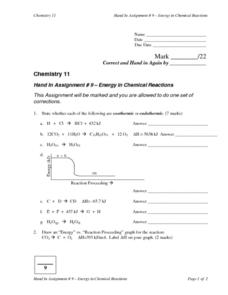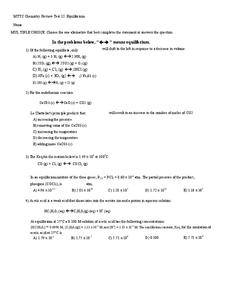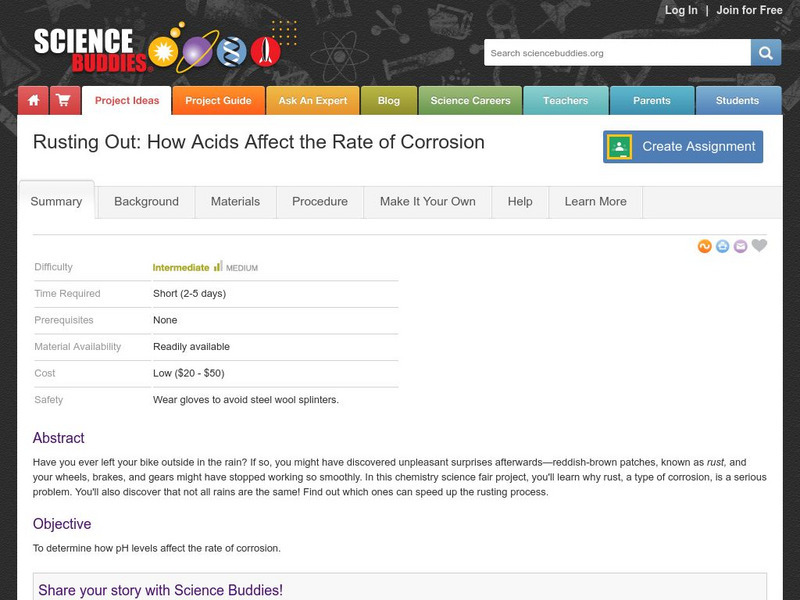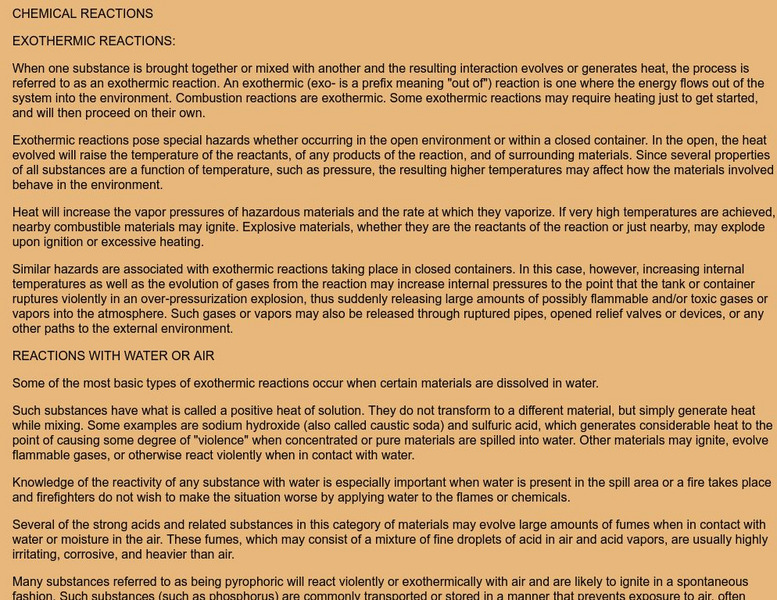Curated OER
Properties of Ionic Compounds
In this compounds instructional activity, students describe why metals and nonmetals form ionic compounds and why the formation of ionic compounds are exothermic. This instructional activity has 5 short answer questions.
Curated OER
Hot Meals on Hand
In this exothermic reactions worksheet, students read about how commercial hot meals are heated through the use of exothermic reactions. They graph data of temperature and time elapsed for hot meals and answer two questions about the graph.
Curated OER
Kinetics and Equilibrium
In this kinetics and equilibrium worksheet, students use the diagram to answer the questions as it relates to endothermic or exothermic reactions. Students indicate the result in the reaction rate as speeding up or slowing down.
Curated OER
Entropy and Free Energy
In this entropy activity, students define entropy and determine if reactions are exothermic or would occur spontaneously. This activity has 10 problems to solve.
Curated OER
Energy in Chemical Reactions
In this chemical reaction worksheet, students determine if reactions are exothermic or endothermic. Students define enthalpy and calculate how much heat is released or absorbed during reactions. This worksheet has 1 matching, 1 fill in...
Curated OER
Potential Energy Diagrams
In this reactions worksheet, students use graphs showing reaction progress to determine if the reaction is exothermic or endothermic, the activation energy, and the enthalpy of change. This worksheet has 1 graph, 7 short answer, and 16...
Curated OER
Equilibrium, Enthalpy and Entropy
In this chemical reactions worksheet, young scholars determine what is true about a system at equilibrium and give examples of macroscopic properties. Students determine minimum enthalpy and maximum entropy for reactions. This worksheet...
Curated OER
Equilibrium
In this equilibrium worksheet, students predict the concentrations of solutions at equilibrium and apply Le Chatelier's principle to systems at equilibrium. This worksheet has 15 multiple choice questions.
Curated OER
Free Energy Formula
In this chemical reaction worksheet, students use the free energy formula to determine if reactions are spontaneous or not. This worksheet has 5 problems to solve.
Curated OER
Chemistry Worksheet 6
In this chemistry worksheet, students calculate specific changes that take place with different chemical reactions. Students indicate whether the reactions are endothermic or exothermic and spontaneous or nonspontaneous.
Curated OER
Exothermic and Endothermic Changes
Pupils define and identify endothermic/exothermic reactions. Using a series of experiments, they construct and interpret potential energy diagrams for their reactions.
Curated OER
Exothermic Reactions
Students experiment, observe, measure, and analyze what occurs during an exothermic reaction. They safely design an experiment, control variables, and properly dispose of materials.
Curated OER
Hot Rocks
Learners demonstrate that setting of plaster and cement is a change, which involves a release of heat energy, use data collected experimentally to construct comparison graphs and analyze the graphs to make predictions about future...
Curated OER
Heat Loss and Gain in Physical Changes and Chemical Reactions
Students compare and contrast exothermic and endothermic reactions. In this chemistry lesson, students perform experiments to determine whether heat was released or absorbed in a reaction. They share their observations in class.
Curated OER
Chemical Reactions
In this reactions worksheet, students state the differences between a coefficient and subscript and an exothermic and endothermic reaction. Students review the different types of reactions. This worksheet has 13 short answer questions.
Curated OER
Chemistry Practice
In this chemistry practice worksheet, students select the correct response to the given questions. Students apply knowledge about the states of matter, finding vapor pressure and atmospheric pressure.
Curated OER
Combustion
In this combustion pre-lab worksheet, students determine the chemical equation for the reaction, define combustion and exothermic, and describe the molar heat of combustion. This worksheet has 14 short answer questions.
Curated OER
Magic Genie
Learners observe the chemical change that occurs when sodium iodide is dropped into a flask containing 30% hydrogen peroxide. They discuss how this exothermic reaction occurred as they study the chemical equation involved in the reaction.
Science Buddies
Science Buddies: Project Ideas: How Acids Affect the Rate of Corrosion
In this chemistry science fair project, students will investigate how pH levels affect the rate of a common form of corrosion, called rusting. The Science Buddies project ideas are set up consistently beginning with an abstract,...
Science Buddies
Science Buddies: Project Ideas: Explore the Chemistry Within Hand Warmers
Determine how the starting temperature affects crystal growth and heat generation of a hand warmer in this chemistry science fair project. The Science Buddies project ideas are set up consistently beginning with an abstract, objective,...
Science Buddies
Science Buddies: Bring on the Heat! Investigating Exothermic Reaction Rates
Have you ever pulled a muscle or just been sore after a long day of work or exercise? Hot showers are great, but maybe you've used the more convenient heat packs. Heat packs, which you can buy at grocery or drug stores to soothe aching...
Other
Chemical Reax/exothermic Reactions
A wonderfully complete primer on exothermic reactions in the context of chemical spills. Covers Reactions with Air or Water, Combustible Organics, Polymerization Reax, Decomposition, Corrosion, and much much more.
Scientific American
Scientific American: What Is an Exothermic Reaction
Scientific American magazine, in the person of Dr. Gerald R. Van Hecke, gives a wonderfully complete answer to this question. Complete with very many hot words for additional background. And a wonderful NASA launch photo.
Texas Education Agency
Texas Gateway: Thermochemical Equations
Given descriptions, diagrams, scenarios, or chemical symbols, students will calculate the energy changes and identify exothermic and endothermic reactions.

























